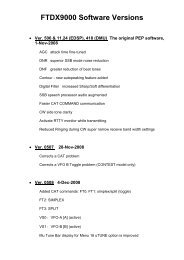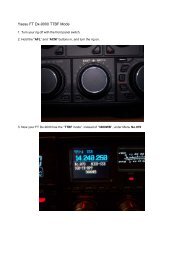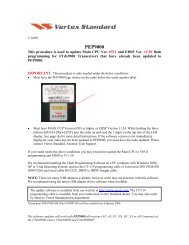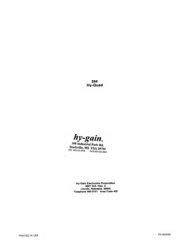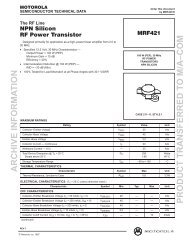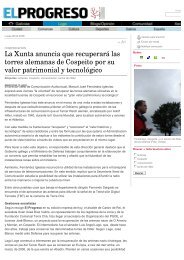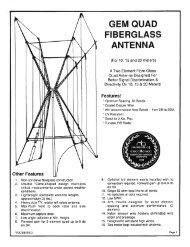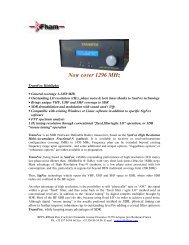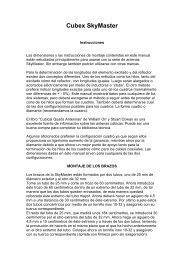You also want an ePaper? Increase the reach of your titles
YUMPU automatically turns print PDFs into web optimized ePapers that Google loves.
Coaxial Transmitting <strong>Choke</strong>s<br />
Jim Brown K9YC<br />
Santa Cruz, CA<br />
http://audiosystemsgroup.com<br />
Understanding Common Mode<br />
and Differential Mode Currents<br />
on Transmission Lines<br />
1
Differential Mode Current<br />
• Transmission line carrying power from<br />
transmitter to antenna, or from antenna to<br />
receiver<br />
• Signal is voltage between the two<br />
conductors<br />
• Current flows out on one conductor and<br />
returns on the other<br />
I<br />
I<br />
2
Differential Mode Current<br />
• Transmission line carrying power from<br />
transmitter to antenna, or from antenna to<br />
receiver<br />
• Signal is voltage between the two<br />
conductors<br />
• Current flows out on one conductor and<br />
returns on the other<br />
• Fields exist between the two conductors<br />
• No radiation from ideal line<br />
– Field of outgoing conductor cancels field of<br />
return conductor<br />
Common Mode Current<br />
• Equal and flowing in the same direction<br />
on all conductors of balanced lines<br />
• Current flows lengthwise on the line<br />
– No cancellation of one current by another,<br />
because they’re in polarity<br />
• Line acts as long wire antenna<br />
– It radiates and it receives<br />
3
Common Mode<br />
It’s an Antenna<br />
Common Mode<br />
Ham Antennas and Balance<br />
• Most ham antennas are unbalanced<br />
by their surroundings, even when<br />
fed by a balanced source and line<br />
4
What Makes a Balanced Circuit?<br />
What Makes a Balanced Circuit?<br />
• The impedances of each<br />
conductor to the reference<br />
plane are equal<br />
• Balance is not defined by<br />
voltage or current<br />
5
Ham Antennas and Balance<br />
• Most ham antennas are unbalanced<br />
by their surroundings, even when<br />
fed by a balanced source and line<br />
–Unequal capacitances to nearby<br />
conductors<br />
–Unequal inductive coupling to<br />
nearby conductors<br />
–Trees, buildings, towers, terrain<br />
–Coax is not a part of this imbalance<br />
Common Mode<br />
6
Common Mode<br />
Current<br />
Unbalanced Antennas and Lines<br />
• If the antenna is unbalanced<br />
–Unequal voltage and current to<br />
earth<br />
–Unequal currents on the feedline<br />
–The difference is common mode<br />
current, and it radiates from the<br />
line<br />
• Coax did not cause the<br />
imbalance in these antennas!<br />
7
The Fields around Coax and<br />
Twinlead are Very Different<br />
Coax is Special<br />
• All the differential power (and<br />
field) is confined inside the coax<br />
• All the common mode power<br />
(and field) is outside the coax<br />
• A ferrite core surrounding coax<br />
sees only the common mode<br />
power (and field)<br />
8
Coax is Special<br />
• Skin effect splits the shield into<br />
two conductors<br />
–Inner skin carries differential mode<br />
current (the transmitter power)<br />
–Outer skin carries common mode<br />
current (the current due to<br />
imbalance)<br />
Twinlead Has Leakage Flux<br />
from Differential Current<br />
• This leakage flux is not confined to the<br />
region between the conductors, but<br />
instead spills to the area immediately<br />
surrounding the conductors<br />
• Leakage flux causes very little radiation,<br />
but it will cause heating in a lossy<br />
medium!<br />
9
How Much Leakage Flux?<br />
• Depends on mutual coupling between<br />
conductors<br />
– Depends on conductor-to-conductor spacing<br />
– How close together can conductors be?<br />
• Coupling coefficient of 60-70% typical<br />
– 30-40% leakage flux in best balanced cables<br />
We’ll talk more about all this later on<br />
Now We Can Talk About<br />
Common Mode <strong>Choke</strong>s!<br />
10
What’s a Common Mode <strong>Choke</strong>?<br />
• A circuit element that reduces<br />
common mode current by<br />
adding a high impedance in<br />
series with the common mode<br />
circuit<br />
–Reduces radiation from the coax<br />
–Reduces reception by the coax<br />
Some Common Mode <strong>Choke</strong>s<br />
• A coil of coax at the antenna<br />
• A stack of ferrite beads around<br />
coax (Walt Maxwell, W2DU)<br />
• Multiple turns of transmission line<br />
through a toroid or stack of toroids<br />
• Most 1:1 “baluns” are common<br />
mode chokes<br />
11
Why Transmitting <strong>Choke</strong>s?<br />
• Isolate antenna from its feedline<br />
• Reduce receive noise<br />
• Keep RF out of the shack<br />
• Minimize antenna interaction<br />
–SO2R, Multi-multi<br />
12
Receive Noise<br />
Common Mode<br />
Current<br />
RF in the Shack<br />
Design of Transmitting <strong>Choke</strong>s<br />
• Higher impedance is better!<br />
– Reduces common mode current<br />
– Reduces noise<br />
– Reduces interaction<br />
– Reduces RF in the shack<br />
– Reduces dissipation<br />
• Resistance is better than reactance<br />
–Not sensitive to feedline length<br />
–Reactance can resonate with line<br />
13
A “String of Beads” (W2DU, W0IYH Balun)<br />
Small bead used in W2DU <strong>Choke</strong><br />
HF Bands<br />
1 MHz 10 MHz 100 MHz 1 GHz<br />
14
W2DU <strong>Choke</strong><br />
• A “string of beads” choke<br />
• Original W2DU used #73 mix (good)<br />
• Increasingly resistive above 3 MHz<br />
– Not very sensitive to feedline length<br />
• Much better than bead of W0IYH choke<br />
• But many more beads are needed<br />
• #73 only made to fit RG58 or RG303<br />
Inductive<br />
Capacitive<br />
15
#43 Bead used in W0IYH <strong>Choke</strong><br />
HF Bands<br />
Inductive<br />
1 MHz 10 MHz 100 MHz 1 GHz<br />
W0IYH <strong>Choke</strong><br />
• Also a “string of beads” choke<br />
• Predominantly inductive below 25 MHz<br />
– Very sensitive to feedline length<br />
– Inductance resonates with a capacitive<br />
line<br />
• Increasingly resistive above 25 MHz<br />
– Much less sensitive to feedline length<br />
• Not very effective below 15 meters!<br />
16
A #31 Bead for the String<br />
(Fits RG8)<br />
HF Bands<br />
Inductive<br />
1 MHz 10 MHz 100 MHz 1 GHz<br />
Using #31 Beads in the String<br />
17
Using #31 Beads in the String<br />
DX Engineering 50Ω <strong>Choke</strong> Balun<br />
$140<br />
18
DX Engineering 200Ω –50Ω<br />
$130 <strong>Choke</strong> Balun<br />
What About Heat?<br />
• Heat (Power) is I 2 R<br />
–Make R large<br />
–I reduces in proportion to R<br />
–P reduces as I 2 so power<br />
(heat) is dropping twice as<br />
fast as R is increasing<br />
19
What About Heat?<br />
• Heat is not a problem if R (the<br />
choking impedance) is large<br />
enough<br />
• How large is enough?<br />
–At maximum ham power, 5,000 Ω<br />
allows a very comfortable margin<br />
See K9YC’s <strong>Choke</strong> Cookbook<br />
(Chapter 7 in the RFI Tutorial) for<br />
specific recommendations<br />
http://audiosystemsgroup.com/RFI-Ham.pdf<br />
20
W2FMI <strong>Choke</strong> Balun<br />
(Discontinued by DX Engineering)<br />
WX0B Still Sells Them – $96-$126<br />
Twin Lead <strong>Choke</strong>s<br />
• Twin lead has 30-40% leakage flux<br />
– <strong>Choke</strong> sees at least 30-40% of transmit<br />
power plus the common mode voltage<br />
– Much more likely to overheat<br />
– More likely to saturate (harmonics, IMD,<br />
splatter, choking impedance drops)<br />
• Must use low loss cores #61, #67<br />
21
Single Wire <strong>Choke</strong>s on a #61 toroid<br />
Inductive<br />
Twin Lead (W2FMI) <strong>Choke</strong><br />
• Wound on #61 Material<br />
• Predominantly inductive below 20 MHz<br />
– Very sensitive to feedline length<br />
– Inductance resonates with a capacitive<br />
line<br />
• Twin-lead construction puts 30-40% of<br />
transmit power in ferrite<br />
– Loss<br />
– Overheating<br />
– Distortion (splatter, harmonics)<br />
• Not much choking Z below 10 MHz<br />
22
K9YC <strong>Choke</strong>s<br />
(Improved W2DU<br />
<strong>Choke</strong>s)<br />
5 turns Big<br />
Clamp-On<br />
RG8X<br />
4 turns<br />
RG8<br />
5 turns<br />
RG8<br />
7 turns<br />
RG8X<br />
An 80/40 Fan Dipole<br />
23
An 80/40 Fan Dipole<br />
Closely Spaced Turns for an 80/40 Fan Dipole<br />
24
Wide Spaced Turns for an 20/15/10 Fan Dipole<br />
Why Use Wound <strong>Choke</strong>s<br />
• Impedance increases as the square of<br />
the number of turns<br />
• Inductance increases as the square of<br />
the number of turns<br />
• Capacitance increases with more turns<br />
– Capacitance through ferrite core<br />
– Capacitance between turns<br />
• So Resonant frequency drops<br />
– With 1-2 turns it’s a VHF choke<br />
– With 4 – 8 turns it’s an HF choke<br />
25
Wide or Close Spacing?<br />
• Close spacing lowers resonant frequency<br />
– More capacitance<br />
– More inductance<br />
• Close spacing may be better below 10 MHz<br />
• Wide spacing usually best above 10 MHz<br />
• Study the K9YC data and Cookbook for<br />
specific applications<br />
26
The Measurement Problem<br />
Measuring Coax <strong>Choke</strong>s<br />
• Very difficult to measure<br />
• Traditional “reflection” measurements<br />
don’t work<br />
– Poor accuracy if 5 ohms > Zx > 500 ohms<br />
• Stray capacitance of fixture causes<br />
additional errors<br />
– Some VNA’s that claim to subtract it out<br />
don’t<br />
• A lot of smart people have<br />
missed all this!<br />
27
What are we Trying to Measure?<br />
56 µH<br />
4,400 Ω<br />
0.9 pF<br />
Fixture<br />
What are we Trying to Measure?<br />
56 µH<br />
4,400 Ω<br />
0.9 pF<br />
2 pF<br />
Typical “good” analyzers<br />
28
What are we Trying to Measure?<br />
56 µH<br />
4,400 Ω<br />
0.9 pF<br />
10 pF<br />
Typical “antenna” analyzers<br />
What are we Trying to Measure?<br />
56 µH<br />
4,400 Ω<br />
0.9 pF<br />
0.4 pF<br />
My measurement setup<br />
29
The Measurement<br />
Problem<br />
56 uH<br />
0.9 pF<br />
4,400 Ω<br />
Q = 0.54<br />
Measuring Coax <strong>Choke</strong>s<br />
30
Curve Fitting<br />
Compare to 5 Turns RG8 on 7 #31 Cores<br />
320 uH<br />
4 pF<br />
6,600 Ω<br />
Q = 0.73<br />
32
Curve Fitting<br />
Compare to 7 Turns RG8X on 5 #31 Cores<br />
590 uH<br />
4.3 pF<br />
7,800 Ω<br />
Q = 0.7<br />
33
The Measurement Problem<br />
Stray Capacitance<br />
Compare to 4 Turns RG8 on 5 #31 Cores<br />
56 uH<br />
0.9 pF<br />
4,400 Ω<br />
Q = 0.54<br />
56 uH<br />
1.3 pF<br />
4,400 Ω<br />
Q = 0.67<br />
34
Curve Fitting – #31 HF-VHF Clamp-<br />
On Fair-Rite 0431164281<br />
Lp = 0.5 uH<br />
Cp = 1.5 pF<br />
Rp = 275 Ω<br />
Q = 0.5<br />
1.55”<br />
0.25”<br />
.385”<br />
35
Curve Fitting – #61 UHF Clamp-On<br />
Fair-Rite 0461164281<br />
Lp = 0.4 uH<br />
Cp = 0.2 pF<br />
Rp = 425 Ω<br />
Q = 0.3<br />
1.55”<br />
0.25”<br />
.385”<br />
Curve Fitting –14 turns on #78 Toroid<br />
Dimensional Resonance Dominates<br />
Lp = 700 uH<br />
Cp = 60 pF<br />
Rp = 6,500 Ω<br />
Q = 1.9<br />
36
Curve Fitting –14 turns on #31 Toroid<br />
Lp = 650 uH<br />
Cp = 2.2 pF<br />
Rp = 5,800 Ω<br />
Q = 0.34<br />
Curve Fitting –14 turns on #43 Toroid<br />
Lp = 210 uH<br />
Cp = 1.9 pF<br />
Rp = 9,000 Ω<br />
Q = 0.86<br />
37
<strong>Choke</strong>s as “Egg Insulators to<br />
Break Up the Feedline<br />
38
NEC Model of Feedline<br />
Interaction with Tee Vertical<br />
NEC Model of Feedline<br />
Interaction with Tee Vertical<br />
39
A <strong>Choke</strong> as the End Insulator<br />
of a Vertical Dipole<br />
41
#12 White THHN<br />
Center Insulator<br />
RG6<br />
End Insulator for a 40M Dipole<br />
• 6 turns of RG6 around a “big clamp-on” is<br />
enough for 500 watts of serious contesting<br />
– About 5,000Ω resistive impedance<br />
• Two of these 6-turn chokes are needed for<br />
1.5kW<br />
– About 10,000Ω resistive impedance<br />
43
Before you fall in love with a vertical<br />
dipole, compare it to a horizontal dipole!<br />
Broadside to Horizontal Dipole<br />
Horizontal<br />
Before you fall in love with a vertical<br />
dipole, compare it to a horizontal dipole!<br />
60 Degrees off-axis of Horizontal Dipole<br />
45
Before you fall in love with a vertical<br />
dipole, compare it to a horizontal dipole!<br />
Off the end of Horizontal Dipole<br />
W1HIS Coaxial <strong>Choke</strong><br />
#43<br />
cores<br />
46
Two Clamps on RG8<br />
Binocular is not better!<br />
Thanks to Kevin, K6TD<br />
• Helped me verify my suspicions about<br />
reflection-based measurements, and get<br />
good S21 data using his HP Network<br />
Analyzer<br />
(Unfortunately, we didn’t have the extra<br />
hardware to get complex data out of the<br />
analyzer into a spreadsheet.)<br />
47
7 Turns-RG8 Thru 5 Cores<br />
Tight-Spaced<br />
S 21 Measurement – <strong>Choke</strong> in Series<br />
7 Turns-RG8 Thru 5 Cores<br />
Tight-Spaced<br />
48
7 Turns-RG8 Thru 5 Cores<br />
Wide-Spaced<br />
S 21 Measurement – <strong>Choke</strong> in Series<br />
7 Turns-RG8 Thru 5 Cores<br />
Wide-Spaced<br />
49
Thanks to Chuck, W1HIS<br />
• Chuck was right about using 5,000Ω<br />
chokes to minimize receive noise<br />
• Chuck was wrong about how to build<br />
5,000Ω chokes, because he (and his<br />
friends) didn’t know how to measure them<br />
correctly!<br />
More Thanks<br />
• Walt Maxwell, W2DU, for starting it all, his<br />
great writing, and for kind words.<br />
• Danny, K6MHE, for prodding me to<br />
participate in a measurement roundtable<br />
that confirmed my work<br />
• Henry Ott, WA2IRQ, for his insights,<br />
criticism, advice, and great teaching.<br />
• Ron Steinberg, K9IKZ, for lots of help at<br />
critical times.<br />
• The NCCC crew, for lots of antenna help.<br />
50
Thanks to Richard Heyser<br />
Dick’s “day job” was at JPL, working on<br />
underwater communications and<br />
communications for the space program, but<br />
audio was his hobby.<br />
Dick invented Time Delay Spectrometry (TDS),<br />
which revolutionized audio by revolutionizing<br />
acoustic measurements. He was an articulate<br />
writer and teacher, who taught us how to<br />
always think about what we were measuring, to<br />
always question the meaning of the data on the<br />
screen.<br />
References<br />
• Henry Ott, Noise Reduction Techniques in<br />
Electronic <strong>Systems</strong>, Wiley Interscience, 1988<br />
• E. C. Snelling, Soft Ferrites, Properties and<br />
Applications, CRC Press, 1969<br />
• E. C. Snelling and A. D. Giles, Ferrites for Inductors<br />
and Transformers, Research Study Press, 1983<br />
• Fair-Rite Products Catalog This 200-page catalog is<br />
a wealth of product data and applications guidance<br />
on practical ferrites. http://www.fair-rite.com<br />
• Ferroxcube Catalog and Applications Notes More<br />
online from another great manufacturer of ferrites.<br />
http://www.ferroxcube.com<br />
51
References<br />
• New Understandings of the Use of Ferrites in the<br />
Prevention and Suppression of RF Interference to<br />
<strong>Audio</strong> <strong>Systems</strong> , J. Brown (AES Preprint 6564)<br />
• Understanding How Ferrites Can Prevent and<br />
Eliminate RF Interference to <strong>Audio</strong> <strong>Systems</strong>, J.<br />
Brown Self-published tutorial (on my website)<br />
• A Ham’s Guide to RFI, Ferrites, Baluns, and <strong>Audio</strong><br />
Interfacing Self-published tutorial (on my website)<br />
Applications notes, tutorials, and my AES papers<br />
are on my website for free download<br />
http://audiosystemsgroup.com/publish<br />
Coaxial Transmitting <strong>Choke</strong>s<br />
Jim Brown K9YC<br />
Santa Cruz, CA<br />
http://audiosystemsgroup.com<br />
52



